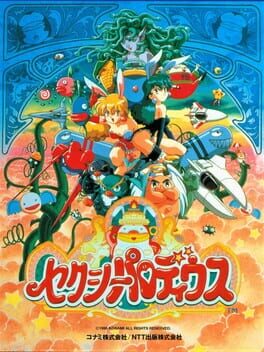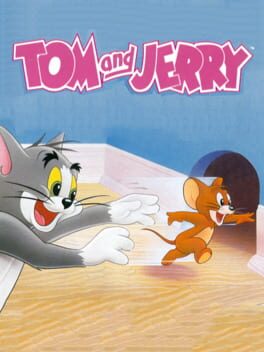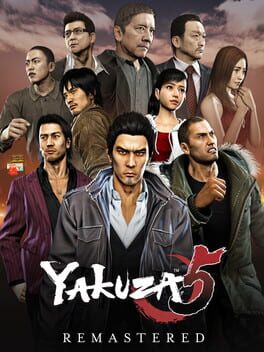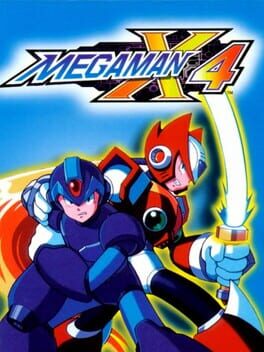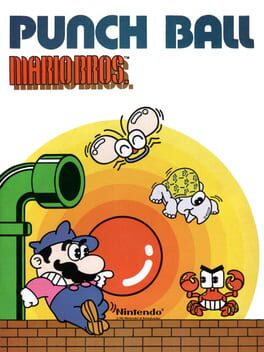MarshSMT
8 reviews liked by MarshSMT
Sexy Parodius
1996
Tom and Jerry
1991
Yakuza 5 Remastered
2019
it’s insane how each entry in this series just keeps getting better and better. this game tells an utterly massive story, with so many different plot threads that all somehow come together perfectly to create my favorite ending so far. Yakuza 5 is a story about what it means to pursue a dream, what it means to pass on that dream, and what it means not to give up. presented absolutely beautifully, somehow we’ve reached new heights in a series that already soars to those of the highest sky scrapers. I couldn’t begin to organize all of my thoughts on this game— it’s one of the biggest i’ve played in my life. It’s worth every second of it though, there really isn’t a truly bad moment here. the best iteration of the combat so far in the series, and as mentioned, an absolutely wonderful story. I have no further notes… it was kino
Mega Man X4
1997
SimCity
1991
"On the other hand, however, there are people who still only use stone. How do they catch game and defend themselves from outsiders? Using only their strong jumping power and stone spheres. They use those skillfully to defend themselves. Here, we introduce two such people. It seems their names are Mario and Luigi. Will they ever learn about sophisticated culture?" These wry words from the game's manual point to the absurdity of Mario Bros., but also the predicament that Hudson Soft's version of the game found itself in. Spread over so many Japanese PC platforms in October 1984, it's a seemingly simplistic variation on the arcade original in a time of rapidly evolving competition from developers at Namco and elsewhere. What more can a few overburdened programmers crank it out before the window of success for this type of game disappears?
Punch Ball Mario Bros. is fun enough despite its platform limitations and unwillingness to go farther with its deviations from the source material; it's also a benchmark for the systems it got ported across. Hudson knew how to get the most from their partnership with Nintendo, bringing conversions like this everywhere it made sense. The weaker but cheaper PC-6001? Yep. The graphically powerful but expensive Sharp X1? Why of course! And it's fascinating to see how much the coders wrought from less powerful PC hardware vs. the best of the bunch, too. I was expecting major sprite and color clash going into the PC-6001mkII version, yet it felt hardly less clean and responsive to play than the Sharp PC varieties. (Considering the X1 has its own sprite-ing hardware, its stiff performance had me underwhelmed.) I expected Hudson to struggle with the FM-7's poor keyboard I/O, however, and that bore true.
See, there's a problem afflicting so many FM-7 games, at least the ones reliant on predictable inputs: the system doesn't fully poll keyboard inputs. This means you can tap anywhere on the numpad (or "tenkey") to move a direction and the game will act as if you're holding that down. But while that first input's still active, no further repeats of it are counted; this doesn't enable a soft autofire, basically. FM-7 keyboard play manages to wedge itself into the worst of both worlds, and I find action games for the system less pleasant for it. The only way to mitigate this is building up muscle memory, tapping a neutral key (ex. "5" on numpad) to reset your movement or switch to another constant action. This habit does help with other versions of Punch Ball Mario Bros., thankfully, since returning to neutral means conserving momentum and, thus, narrowly avoiding critters, fireballs, and other hazards. Sure, the other NEC and Sharp PCs don't suffer anything like the FM-7, but it's ultimately helpful to internalize these controls and work around the lag.
Judging ground and air momentum matters even more here than in Nintendo's game because your main trap-em-up mechanic is throwing a ball, not bumping enemies from below. It's a neat lil' twist on Mario Bros., incentivizing more tactical movement to line up shots and then recover your weapon afterward. The ever-present pipe in the middle provides a route back to the top-center of the action; dropping the stone below resets it atop the POW block. Since the space key fires at neutral and lets you jump when running, the player has to act more deliberately than ever. Your ability to fight at the ground level adds a feeling of empowerment missing in the arcade game, turning this into an action-platforming hybrid without any use for hammers or other power-ups. Where Miyamoto and co. saw their design as leaving players exposed to threats depending on the level layer they're on, Hudson figured their PC audience would be familiar enough with that paradigm to want something different…something aggressive. I could chew right through this game with extra practice, playing faster than the original generally allows.
Compared with Mario Bros. Special, this later port hews closer to what Nintendo must have expected from their new bedfellows, yet the game design comes out subtly different in a manner reflecting different hardware. Punch Ball Mario Bros. doesn't need to employ the myriad gimmicks of its cousin because it's already diverged from the jumping-first model. That's a problem because, as satisfying as it can be to chuck dodgeballs at turtles, the combat never gets any deeper or more explosive. In trying to find the balance between speed, quantity, and quality for their Famicom-to-PC schedule, Hudson ended up compromising most on ambition. Someone's going to accuse me of being unfair, given the obvious additions and reductions in these PC versions, but I just feel like the developers could have gone farther. Awkward co-op via a shared keyboard means these releases needed a lot to distinguish themselves from a trip to the local cabinet, as demonstrated by the excesses of Donkey Kong 3 and Super Mario Bros. Special. Everyone at the company knew that the future wasn't strict arcade adaptations, but remakes like what Nuts & Milk received when it jumped from PC to Famicom.
I won't hold that quality of spareness too hard against Punch Ball Mario Bros.. It's disappointing how slight in new content and mix-ups this version has, yet it still plays well within its constraints. Switching from bumpin' to ballin' no doubt circumvented the rendering and physics problems of the former on these PCs, and it's a small miracle that the end product looks and sounds this consistently everywhere you can run it. Producing this many multiplatform ports is never easy, even back in the bedroom coding era, so it's cool to witness Hudson working their magic in that regard. Most importantly, I think it's telling that Mario fans poo-poo the mid-'80s J-PC ports while conveniently ignoring this one to fixate on SMB1's misfire instead. PC users of the time had seen considerably worse efforts, even from Nintendo's original PC porting partner Westside. The Famicom had undeniable sprite-ing and scrolling advantages over contemporary PCs and Hudson still proved you could bring similar experiences to those machines largely intact. Arcade perfect wasn't the name of the day, but it's surprising and awesome when talented coders got close. Perhaps the worst I can say about this game is that no amount of fidelity would have elevated Mario Bros. beyond the system exclusives and genre revolutions to come.
Punch Ball Mario Bros. is fun enough despite its platform limitations and unwillingness to go farther with its deviations from the source material; it's also a benchmark for the systems it got ported across. Hudson knew how to get the most from their partnership with Nintendo, bringing conversions like this everywhere it made sense. The weaker but cheaper PC-6001? Yep. The graphically powerful but expensive Sharp X1? Why of course! And it's fascinating to see how much the coders wrought from less powerful PC hardware vs. the best of the bunch, too. I was expecting major sprite and color clash going into the PC-6001mkII version, yet it felt hardly less clean and responsive to play than the Sharp PC varieties. (Considering the X1 has its own sprite-ing hardware, its stiff performance had me underwhelmed.) I expected Hudson to struggle with the FM-7's poor keyboard I/O, however, and that bore true.
See, there's a problem afflicting so many FM-7 games, at least the ones reliant on predictable inputs: the system doesn't fully poll keyboard inputs. This means you can tap anywhere on the numpad (or "tenkey") to move a direction and the game will act as if you're holding that down. But while that first input's still active, no further repeats of it are counted; this doesn't enable a soft autofire, basically. FM-7 keyboard play manages to wedge itself into the worst of both worlds, and I find action games for the system less pleasant for it. The only way to mitigate this is building up muscle memory, tapping a neutral key (ex. "5" on numpad) to reset your movement or switch to another constant action. This habit does help with other versions of Punch Ball Mario Bros., thankfully, since returning to neutral means conserving momentum and, thus, narrowly avoiding critters, fireballs, and other hazards. Sure, the other NEC and Sharp PCs don't suffer anything like the FM-7, but it's ultimately helpful to internalize these controls and work around the lag.
Judging ground and air momentum matters even more here than in Nintendo's game because your main trap-em-up mechanic is throwing a ball, not bumping enemies from below. It's a neat lil' twist on Mario Bros., incentivizing more tactical movement to line up shots and then recover your weapon afterward. The ever-present pipe in the middle provides a route back to the top-center of the action; dropping the stone below resets it atop the POW block. Since the space key fires at neutral and lets you jump when running, the player has to act more deliberately than ever. Your ability to fight at the ground level adds a feeling of empowerment missing in the arcade game, turning this into an action-platforming hybrid without any use for hammers or other power-ups. Where Miyamoto and co. saw their design as leaving players exposed to threats depending on the level layer they're on, Hudson figured their PC audience would be familiar enough with that paradigm to want something different…something aggressive. I could chew right through this game with extra practice, playing faster than the original generally allows.
Compared with Mario Bros. Special, this later port hews closer to what Nintendo must have expected from their new bedfellows, yet the game design comes out subtly different in a manner reflecting different hardware. Punch Ball Mario Bros. doesn't need to employ the myriad gimmicks of its cousin because it's already diverged from the jumping-first model. That's a problem because, as satisfying as it can be to chuck dodgeballs at turtles, the combat never gets any deeper or more explosive. In trying to find the balance between speed, quantity, and quality for their Famicom-to-PC schedule, Hudson ended up compromising most on ambition. Someone's going to accuse me of being unfair, given the obvious additions and reductions in these PC versions, but I just feel like the developers could have gone farther. Awkward co-op via a shared keyboard means these releases needed a lot to distinguish themselves from a trip to the local cabinet, as demonstrated by the excesses of Donkey Kong 3 and Super Mario Bros. Special. Everyone at the company knew that the future wasn't strict arcade adaptations, but remakes like what Nuts & Milk received when it jumped from PC to Famicom.
I won't hold that quality of spareness too hard against Punch Ball Mario Bros.. It's disappointing how slight in new content and mix-ups this version has, yet it still plays well within its constraints. Switching from bumpin' to ballin' no doubt circumvented the rendering and physics problems of the former on these PCs, and it's a small miracle that the end product looks and sounds this consistently everywhere you can run it. Producing this many multiplatform ports is never easy, even back in the bedroom coding era, so it's cool to witness Hudson working their magic in that regard. Most importantly, I think it's telling that Mario fans poo-poo the mid-'80s J-PC ports while conveniently ignoring this one to fixate on SMB1's misfire instead. PC users of the time had seen considerably worse efforts, even from Nintendo's original PC porting partner Westside. The Famicom had undeniable sprite-ing and scrolling advantages over contemporary PCs and Hudson still proved you could bring similar experiences to those machines largely intact. Arcade perfect wasn't the name of the day, but it's surprising and awesome when talented coders got close. Perhaps the worst I can say about this game is that no amount of fidelity would have elevated Mario Bros. beyond the system exclusives and genre revolutions to come.
Donkey Kong 3
1983
Some arcade games make it past location testing without issue; occasionally they need some tuning, or a redesign, but nothing prohibitive. Others fail to meet expectations and get canned. A select few survive this stage despite not passing muster, and that's possibly what happened with Donkey Kong 3. It's a sad yet mundane story of a product unable to meet (let alone surpass) its precursors, all the while eclipsed by the genre competitors it was aping.
Our tale begins further back than the original Donkey Kong, however, as this sequel owes much more to Nintendo's ill-fated vertical shooters of the time, particularly Radar Scope and Space Firebird. Both ancestors offered technically competent but uninteresting variations on the ubiquitous Space Invaders formula. To the latter's credit, the developers had a solid grasp on sound and graphical feedback by this point, with players feeling that crunchy impact while mowing down alien hordes. But the lack of risk-reward features like the degrading shields in Taito's game, or the cleverly evolving raid and bullet patterns of Galaga a bit later, meant that these post-Sheriff shooters were just too spare and derivative to stand out. I can definitely see why Nintendo's last attempt to break into the shooter market went for a mix of platforming, puzzling, and blaster action. And they would have had a winner if not for some critical problems in the pernicious primate's latest title.
The dastardly donk's back at it again…in a greenhouse? I suppose it's better than Congo Bongo's colonialist chase through the jungles. Genyo Takeda and Shigeru Miyamoto help provide the customary trappings of an early-'80s Nintendo arcade release, with fairly responsive controls accompanied by a very readable set of graphics. I rarely struggle to figure out what's happening on-screen even way late into a playthrough, and the SFX ring clearly in my ears. Nothing here feels like an evolution beyond Donkey Kong Jr., though. The likes of SEGA and Namco were already starting to produce more audiovisually stimulating stuff like the former's DK clone and the latter's Mappy. Also lacking here is much of the series' humor—the most I can recall is my amusement whenever DK gets his head stuck in the beehive. It's a rather sober outing for not-Mario vs. not-Kong, contrary to expectations that these developers had previously set. I'd be fine with all this if the game design itself was strong, but, well…
Simply put, the game's a bit too easy, with its difficulty level evolving mainly from faster attacks and a few additional enemy types. Our protagonist Stanley may have a measly little pesticide pump to work with, but the admittedly clever goal of scaring DK to the top means it's possible to ignore the bugs and just go for broke. Arguably the most fun I can have with Donkey Kong 3 is exactly that: speedrunning each board to get as high a time bonus as possible, ensuring I can regularly extend my lives. That sounds fun on paper; now imagine this game throwing you a frequent gun power-up which trivializes combat entirely. Sure, you have to actually lose a life for the upgrade to reappear, and there's still some hits on DK to go before it tumbles. But the relative ease of getting 1-ups via fast stage clears means it's often too easy to get this item. One has to play several stages before there's much threat of bees successfully stealing away with your flowers…which means perfect bonuses become a formality rather than a reward. Combine all these flaws and we've got a game loop which struggles to encourage more skillful play and leads to unsatisfying high-score runs.
The echoes of mediocre starfighting action from Nintendo's pre-Donkey Kong bombs reverberate throughout this final numbered entry, contrary to the heights their R&D teams would reach via many Family Computer releases to come. I feel bad for Genyo Takeda especially since he's so often singled out as the one responsible for playable yet dismal software such as this. To me, it doesn't seem as though releases like this suffered from a lack of foresight, ambition, or no-nonsense design. He later directed the StarTropics games, simultaneously within Nintendo's house style and quite distinct from anything Miyamoto's crew were involved with. (Let's also remember that Miyamoto was involved with Donkey Kong 3, yet the besmirchment's sent elsewhere.) Something managed to go wrong with each and every one of the company's arcade shooters, regardless of circumstances, and it's no surprise that they later played it safe with Solar Striker. If there's anything I'll give Donkey Kong 3 credit for, it's that shooting-heavy action platformers were a rarity in 1983. Add this distinction to the game's brand power and I'm unsurprised that it still sold reasonably well to arcade operators in Japan, no matter the lack of staying power. Still, I'd rather play Moon Patrol; even the best PCBs of '83 struggled to match that one in quality and replayability.
Save for its quick appearance on the Famicom, Donkey Kong 3 fell into footnote status much quicker than the average Nintendo hit of the time, and I attribute that to its shortcomings more than just its small delights. There's still a competent action game in here whenever you're unable to immediately trivialize a stage. I had fun timing my shots to avoid blocking myself with stunned snakes. The way Stanley gets wiped out by an ambush of insects is morbidly amusing. And while it becomes too damn straightforward after 15 minutes, I hardly mind this kind of accessible arcade experience after playing some of the period's more punishing stuff. But in exchange for that ease of completion, I expect way more variation in levels, enemy characteristics, and types of traps to deal with. It's because the game settles for so much less than it promises that I can't help but rate it so low. And as 1984's catalog would show, Nintendo themselves knew that the future belonged to increasingly complex and extensible game loops, even for cartridges as constrained as Excitebike. (Hell, it's a wonder that Takeda's own Sky Skipper gets more retrospective praise than anyone ever expected.) In the end, this gassed-up-the-ass gorilla had reached the end of his usefulness; it would take something altogether new and wild to bring back the beast.
Our tale begins further back than the original Donkey Kong, however, as this sequel owes much more to Nintendo's ill-fated vertical shooters of the time, particularly Radar Scope and Space Firebird. Both ancestors offered technically competent but uninteresting variations on the ubiquitous Space Invaders formula. To the latter's credit, the developers had a solid grasp on sound and graphical feedback by this point, with players feeling that crunchy impact while mowing down alien hordes. But the lack of risk-reward features like the degrading shields in Taito's game, or the cleverly evolving raid and bullet patterns of Galaga a bit later, meant that these post-Sheriff shooters were just too spare and derivative to stand out. I can definitely see why Nintendo's last attempt to break into the shooter market went for a mix of platforming, puzzling, and blaster action. And they would have had a winner if not for some critical problems in the pernicious primate's latest title.
The dastardly donk's back at it again…in a greenhouse? I suppose it's better than Congo Bongo's colonialist chase through the jungles. Genyo Takeda and Shigeru Miyamoto help provide the customary trappings of an early-'80s Nintendo arcade release, with fairly responsive controls accompanied by a very readable set of graphics. I rarely struggle to figure out what's happening on-screen even way late into a playthrough, and the SFX ring clearly in my ears. Nothing here feels like an evolution beyond Donkey Kong Jr., though. The likes of SEGA and Namco were already starting to produce more audiovisually stimulating stuff like the former's DK clone and the latter's Mappy. Also lacking here is much of the series' humor—the most I can recall is my amusement whenever DK gets his head stuck in the beehive. It's a rather sober outing for not-Mario vs. not-Kong, contrary to expectations that these developers had previously set. I'd be fine with all this if the game design itself was strong, but, well…
Simply put, the game's a bit too easy, with its difficulty level evolving mainly from faster attacks and a few additional enemy types. Our protagonist Stanley may have a measly little pesticide pump to work with, but the admittedly clever goal of scaring DK to the top means it's possible to ignore the bugs and just go for broke. Arguably the most fun I can have with Donkey Kong 3 is exactly that: speedrunning each board to get as high a time bonus as possible, ensuring I can regularly extend my lives. That sounds fun on paper; now imagine this game throwing you a frequent gun power-up which trivializes combat entirely. Sure, you have to actually lose a life for the upgrade to reappear, and there's still some hits on DK to go before it tumbles. But the relative ease of getting 1-ups via fast stage clears means it's often too easy to get this item. One has to play several stages before there's much threat of bees successfully stealing away with your flowers…which means perfect bonuses become a formality rather than a reward. Combine all these flaws and we've got a game loop which struggles to encourage more skillful play and leads to unsatisfying high-score runs.
The echoes of mediocre starfighting action from Nintendo's pre-Donkey Kong bombs reverberate throughout this final numbered entry, contrary to the heights their R&D teams would reach via many Family Computer releases to come. I feel bad for Genyo Takeda especially since he's so often singled out as the one responsible for playable yet dismal software such as this. To me, it doesn't seem as though releases like this suffered from a lack of foresight, ambition, or no-nonsense design. He later directed the StarTropics games, simultaneously within Nintendo's house style and quite distinct from anything Miyamoto's crew were involved with. (Let's also remember that Miyamoto was involved with Donkey Kong 3, yet the besmirchment's sent elsewhere.) Something managed to go wrong with each and every one of the company's arcade shooters, regardless of circumstances, and it's no surprise that they later played it safe with Solar Striker. If there's anything I'll give Donkey Kong 3 credit for, it's that shooting-heavy action platformers were a rarity in 1983. Add this distinction to the game's brand power and I'm unsurprised that it still sold reasonably well to arcade operators in Japan, no matter the lack of staying power. Still, I'd rather play Moon Patrol; even the best PCBs of '83 struggled to match that one in quality and replayability.
Save for its quick appearance on the Famicom, Donkey Kong 3 fell into footnote status much quicker than the average Nintendo hit of the time, and I attribute that to its shortcomings more than just its small delights. There's still a competent action game in here whenever you're unable to immediately trivialize a stage. I had fun timing my shots to avoid blocking myself with stunned snakes. The way Stanley gets wiped out by an ambush of insects is morbidly amusing. And while it becomes too damn straightforward after 15 minutes, I hardly mind this kind of accessible arcade experience after playing some of the period's more punishing stuff. But in exchange for that ease of completion, I expect way more variation in levels, enemy characteristics, and types of traps to deal with. It's because the game settles for so much less than it promises that I can't help but rate it so low. And as 1984's catalog would show, Nintendo themselves knew that the future belonged to increasingly complex and extensible game loops, even for cartridges as constrained as Excitebike. (Hell, it's a wonder that Takeda's own Sky Skipper gets more retrospective praise than anyone ever expected.) In the end, this gassed-up-the-ass gorilla had reached the end of his usefulness; it would take something altogether new and wild to bring back the beast.

